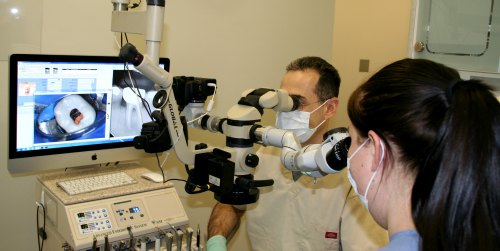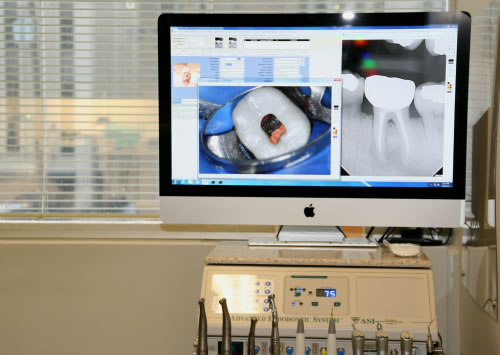What is an Endodontist and what do they do?
Endodontists are dentists who specialize in maintaining teeth through endodontic therapy — procedures, involving the soft inner tissue of the teeth, called the pulp. The word “endodontic” comes from “endo” meaning inside and “odont” meaning tooth. Like many medical terms, it’s Greek. All dentists are trained in diagnosis and endodontic therapy, however, some teeth can be especially difficult to diagnose and treat. That’s why you may have been referred to an endodontic specialist.
In addition to dental school, endodontists receive two or more years of advanced education in this kind of treatment. They study root canal techniques and procedures in greater depth, for diagnosis and treatment of more difficult cases. For this reason, many dentists choose to refer their patients to endodontists.
What happens during Endodontic treatment (a root canal)?
In order to understand Endodontic treatment, it helps to know something about the anatomy of a tooth. Teeth have several layers. The outside layer of the tooth is composed of a hard layer called Enamel. Enamel is supported by an inner layer called Dentin, which has at its center a soft tissue known as the Pulp.
The pulp contains blood vessels, nerves, and connective tissue that are responsible for forming the surrounding Dentin and Enamel during tooth development. The pulp receives its nourishment supply from vessels which enter the end of the root. Although the pulp is important during development of the tooth, it is not necessary for function of the tooth. The tooth continues to be nourished by the tissues surrounding it even after the pulp is removed.
 Let’s look at the basic steps for nonsurgical endodontic therapy. A local anesthetic will be given. A sheet of latex called the “rubber dam” (we’ve got non-latex ones too) will be placed around the tooth to isolate it, hence keeping it clean and dry during treatment. The Endodontist removes the inflammed or infected pulp, carefully cleans and shapes the canal system and then seals the prepared space.
Let’s look at the basic steps for nonsurgical endodontic therapy. A local anesthetic will be given. A sheet of latex called the “rubber dam” (we’ve got non-latex ones too) will be placed around the tooth to isolate it, hence keeping it clean and dry during treatment. The Endodontist removes the inflammed or infected pulp, carefully cleans and shapes the canal system and then seals the prepared space.
Once treatment is completed, you will be instructed to return to your dentist for permanent restoration. The treatment consists of three or four basic steps, but the number of visits will depend on your particular case. Some treatments take 2 visits but many are just a single visit. Occasionally 3 appointments are needed.
In any case, it depends on the degree of infection/inflammation and degree of treatment difficulty. To us, it’s more important to do it the very best we can then to meet a specific time criteria.
There are, of course, no guarantees. Root canal or endodontic therapy has a very high degree of success. Teeth which can be treated near ideal have a success rate over ninety percent! We will discuss with you the chances of success before any endodontic procedure to help you make an informed decision.
Diagnosis and treatment of pain
Oral pain such as toothaches or cracked/fractured teeth can often be difficult to pinpoint. Because of the vast network of nerves in the mouth, the pain of a damaged or diseased tooth often is felt in another tooth and/or in the head, neck, or ear. An endodontist is a specialist in diagnosing and treating this type of pain.
Treatment of traumatic injuries
 Pulp damage is sometimes caused by a blow to the mouth, and the endodontist specializes in treating these traumatic injuries. For example, a blow to a child’s permanent tooth that is not fully developed can cause the root to stop growing. A procedure called apexification stimulates bone to be deposited at the end of the root which makes it possible to then save the tooth through a root canal procedure. An endodontist is specially trained in procedures for replanting teeth that have been knocked out of their sockets.
Pulp damage is sometimes caused by a blow to the mouth, and the endodontist specializes in treating these traumatic injuries. For example, a blow to a child’s permanent tooth that is not fully developed can cause the root to stop growing. A procedure called apexification stimulates bone to be deposited at the end of the root which makes it possible to then save the tooth through a root canal procedure. An endodontist is specially trained in procedures for replanting teeth that have been knocked out of their sockets.
Why would I need Endodontic treatment?
Endodontic treatment is necessary when the pulp becomes inflamed or infected. The most common reasons for inflammation or infection are deep cavities (caries), repeated dental procedures, cracks or chips. Trauma can also cause inflammation and often shows up as discoloration of the tooth. If pulp inflammation or infection is left untreated, it can cause pain or lead to an abscess.
Signs and symptoms
Indications for treatment include prolonged sensitivity to heat or cold, discoloration of the tooth, swelling or tenderness of the tooth or adjacent gums. Sometimes there are no symptoms.
Retreatment
Occasionally a tooth that has undergone endodontic, treatment fails to heal or pain continues despite therapy. Although rare, sometimes a tooth initially responds to root canal therapy but becomes painful or diseased months or years later. When either of these situations occur, the tooth often can be maintained with a second endodontic treatment.


